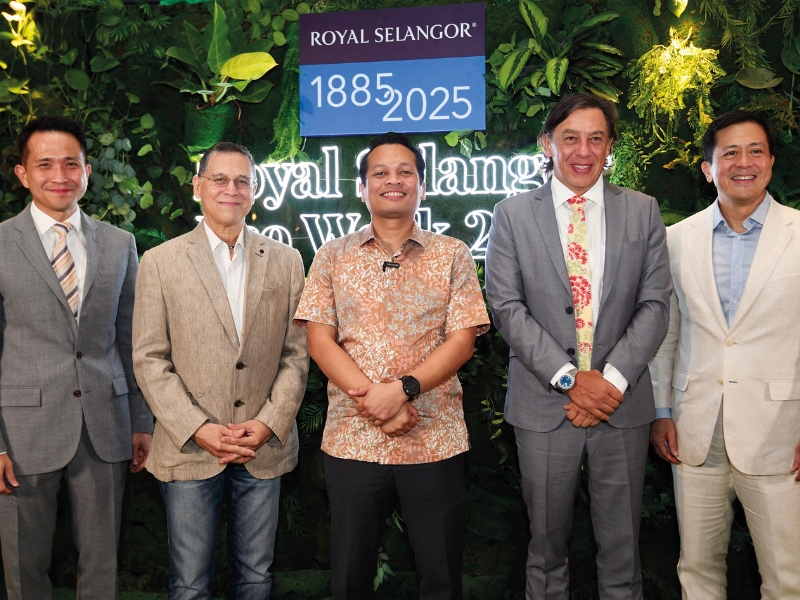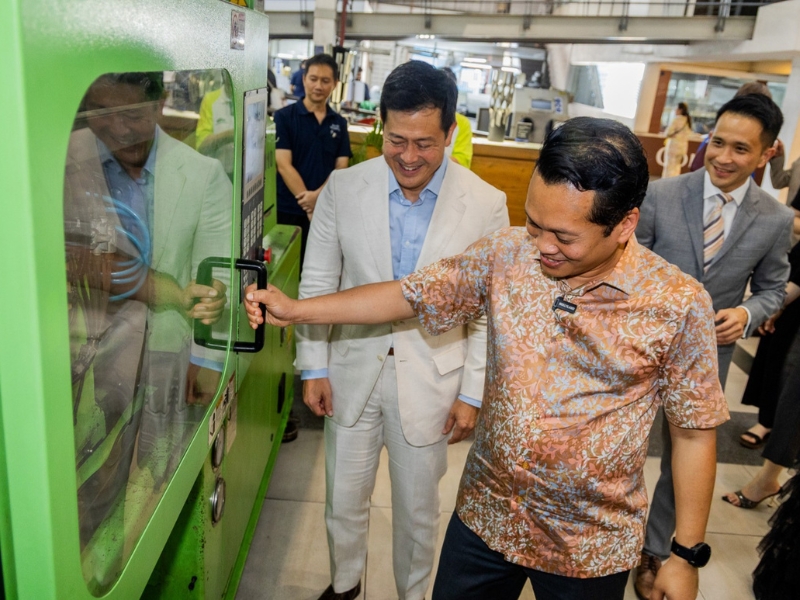
The Tigris collection, made in collaboration with Rimau, features motifs of the endangered Malayan tiger (All photos: Patrick Goh/The Edge)
Stroll down the walkway of the factory at Royal Selangor’s Visitor Centre and you will be greeted with an unforgettable sight. Stretched out before the viewing area are row upon row of workbenches where skilled artisans sit, each absorbed in their work. With a hammer in hand, one makes dimples on a tankard, every mark placed with a precision that comes from years of practice. Another blasts the surface of an ornamental plate with a blowtorch, while two more workers ponder a contraption whose function remains a puzzle to outsiders. From a bubbling cauldron, a craftswoman scoops up molten pewter, pouring it into a mould to make a cup handle. This piece will eventually be smoothed out, awkward seams polished away by careful hands, under watchful eyes.
The well-oiled machine that is Royal Selangor’s production facility runs thanks to the power of the sun. Over 3,000 solar panels crowd the roof of the Visitor Centre, installed in 2019 to generate more than 870kW of electricity. It is this fact that managing director Datuk Yong Yoon Li highlights proudly in his opening speech at the launch of the pewter house’s Eco Week initiative.
“By utilising the government’s Net Energy Metering scheme in 2019, we benefited from cheap, sustainable electricity,” he says, adding that the excess is exported back to the national grid. The inauguration was attended by then minister of natural resources and environmental sustainability Nik Nazmi Nik Ahmad, vice president of non-governmental organisation Rimau and founding director of architectural firm Veritas David Hashim, and Ambassador of Colombia to Malaysia His Excellency Alejandro Rosselli Londoño.
gang.jpg

Royal Selangor, founded by Yong’s great-grandfather in 1885, is no stranger to sustainability, having woven such practices quietly into the fabric of its daily operations. Electric cauldrons now reign supreme where their diesel-fuelled counterparts once stood. Pewter — including old moulds and scraps — silver and gold are melted to form new creations for the house and its sister brands Comyns and Selberan.
Finished pieces are sent to their new homes in flat-packs made of biodegradable kraft paper, an improvement from the packaging boxes that contributed to sawdust waste. Royal Selangor has repurposed said sawdust shavings with plastic pellets to create eco-composite resin, which is integrated into coaster bases, tin caddies and holders for decorative plates.
The company continues to reduce its carbon footprint as environmental conservation is not just about solar-powered machines or a change of wrapper. The Eco Week event gives it the opportunity to take things a step further in its support for non-governmental organisations, spotlighting Rimau this time around.
The group, whose name is derived from the short form of harimau, is dedicated to the preservation of one of the country’s most elusive and gravely endangered creatures, the Malayan tiger. Its work includes educating citizens on the importance of its cause and sourcing funding for anti-poaching surveillance throughout the feline’s natural habitats in Perak.
David, who joined forces with activists dedicated to this noble cause in 2018, was spurred into action after realising his practice directly harmed the planet. Rimau is his way of giving back to the environment. Noting how the big cats were already on the brink of extinction when the group was formed, he brings up how dire it would be for Malaysia to lose an icon so proudly displayed on its coat of arms.
In 2022, his construction firm reached out to Royal Selangor for support, resulting in a collaborative deskware collection dubbed Tigris. The striped monarch of the Malaysian jungle inspired the miniature models that sport sharp, geometric lines atop concrete bases. Part of the sale proceeds for this collection go to Rimau, whose operating costs are steep. To outfit a ranger with proper equipment including trap cameras and rugged phones, the organisation has to fork out RM2,145.
sculptura.jpg

Eco Week is far from Royal Selangor’s first foray into conservation efforts, heritage preservation and sustainability. Through design language, the brand memorialises and celebrates the country’s endangered wildlife in its Tigris, Sculptura, Earth, Heritage and Reunion lines. Comprising figurines of animals such as the leatherback turtle, tapir and orangutan, as well as homeware inspired by these precious creatures, the enterprise continues to push for the need to protect the species for the next generation.
If environmentally friendly practices have become second nature to Royal Selangor, it raises the question of why we do not see more businesses making similar upgrades or taking steps to reduce their carbon footprint. Would investing in cleaner energy sources, closed water systems or reusing old materials risk one’s profits?
David disagrees. “I think [Royal Selangor] recognised early on that, like many smart corporations, going in this direction of being environmentally sustainable is not a zero-sum game. It’s not a choice of whether you’re going to be environmentally stable, or save and make money. That’s a false choice, but a lot of people think that way.”
With mindful practices in place, the pewter goods manufacturer is positioned as a figurehead for corporations to follow in paving a greener way. It purchases raw materials produced by Malaysia Smelting Corp Bhd, which is recognised by the Responsible Minerals Initiative, while keeping actual tin usage low by integrating materials like eco-composite, wood and glass. Wood sourcing and processing practices undergo a Chain-of-Custody System under the Programme for the Endorsement of Forest Certification (PEFC), ensuring the timber used is procured via sustainable harvesting methods.
These efforts are compiled yearly in a report available on the company’s website, although Eco Week invites people to see them in real time. A tour of the Visitor Centre is made more enticing for young ones with the children’s Eco Trail hunt, where one must uncover hidden treasures scattered about the museum, while an injection moulding machine allows curious visitors to witness the process of shaping eco-composite.
machine.jpg

The Hall of Frames has been converted into a screening area for Malaysia’s Last Tigers: The Battle To Save The Malayan Tiger produced by Nuvista Media. First screened in 2022, the documentary details the efforts of experts to track down and preserve tigers in the nation. For something more hands-on, educational booths by the Department of Wildlife and National Parks and Rimau provide pamphlets and models of endangered species.
Even with such initiatives in place, winning the conservation and sustainability fight seems a long way off. Nik Nazmi reassures otherwise. “The idea is that there will be enough awareness and enough pressure, and people will then start to take action.
“Everyone has to play their part. One is government policies, and two, the private sector has to show initiative. Then individual action will be easier to follow through.”
There seems no better time to start than now.
Royal Selangor Eco Week is held daily from 9am to 5pm at the Royal Selangor Visitor Centre until June 29. For more information, visit royalselangor.com.
This article first appeared on June 23, 2025 in The Edge Malaysia.


